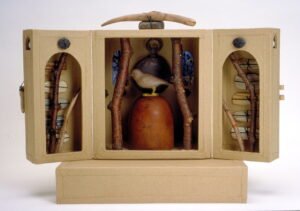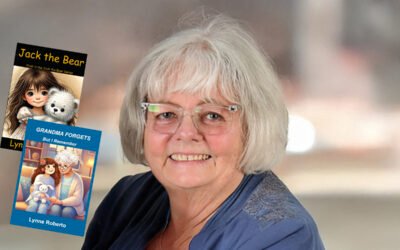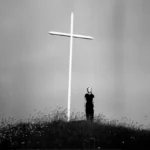Margo Klass Transforms Found Objects Into Sacred Spaces Through Box Constructions And Artist Books

Exploring Space, Spirituality, And The Power Of Found Objects
Mixed media sculptor Margo Klass creates meditative box constructions inspired by medieval altarpieces and Japanese aesthetics, transforming found objects into symbolic narratives while exploring themes of space, light, and spirituality.
Margo Klass transforms ordinary found objects into extraordinary narratives through her masterful box constructions and artist books. The Alaska-based artist’s work speaks volumes about space, spirituality, and the profound connection between objects and meaning. Her remarkable ability to blend medieval influences with Japanese aesthetics creates intimate viewing experiences that invite contemplation and reflection.
Drawing inspiration from Northern Renaissance altarpieces and Japanese roadside sculptures, Klass crafts meticulous compositions where every element – from carefully selected driftwood to discarded materials – takes on new life and symbolism. Her artistic vision extends beyond mere assemblage; she architects spaces within spaces, manipulating light through mica-filled windows and thoughtfully designed openings that transform each piece into a sanctuary of contemplation.
The upcoming interview delves deep into Klass’s creative process, exploring her two-decade-long collaboration with late husband Frank Soos, her innovative approach to storytelling through “Lives of the Saints,” and her profound connection to both the Alaskan wilderness and Maine’s rugged coastline.
Her numerous accolades, including the Governor’s Individual Artist Award and the Rasmuson Foundation recognition, affirm what viewers of her work instantly recognize – Margo Klass is a visionary artist whose box constructions and artist books offer windows into both the physical and spiritual realms of human experience.
What inspired you to start creating box constructions, and how has this art form evolved for you over time?
The genesis of the box-constructed form of my work is two-pronged. Most importantly it grows out of my graduate school study of Northern Renaissance altarpieces whose panels open and close according to the liturgical season of the year and whose individual images are both narrative and, most importantly for me, meditative. It is because of this art historical connection that the box constructions that have doors opening to multiple views are called altarpieces. Secondarily, the box-constructed form grew out of my travels in Japan where small niche-like sculptures are erected in garden and roadside settings to mark particular places at which one is invited to pause, rest, and reflect.
“My work is all about space” – Margo Klass
The compositional hierarchy of objects within each construction is also influenced by both sources of inspiration. From Japanese art comes my aesthetic preference for spare images in which objects, negative space, and light play equal roles. From my medieval study of Early Christian and Carolingian mosaics comes an intuitive hierarchical arrangement of objects along a central axis with objects of increasingly secondary importance flanking the central image, as illustrated by Spirit. Over time compositions have become more asymmetrical, but I come back to this comfort zone of strict symmetry again and again.
Many of your pieces explore themes of architecture and space. How do these concepts influence your creative process?
In some important way my work is all about space – space as majestic as the massive mountain ranges in my home state of Alaska, and as expansive as the ocean outside my studio window in Maine. My intention is to convey that keen awareness of space on a much smaller scale within my box constructions. To impart that sense of space, and to invite the viewer to experience it, I create images using found objects and then design their surrounding architectural spaces. The juxtaposition of positive and negative space, and interplay of light and shadow, is determined by the architecture of the box itself. The walls of the box define the interior space, while mica-filled windows and skylights provide pathways to guide light onto and around (and often behind) the objects.
“I think of rocks and stones as nature’s most essential forms” – Margo Klass
This literal “construction” of space and light around the composition of objects has everything to do with my process. The composition of objects come first; the fabrication of architectural space and light complete the process – objects, space, and light playing equal roles.
How do you choose the found objects that feature in your work? Do they carry personal significance or follow a specific theme?
I seek out my objects on beaches and forest trails, in waste bins and junk stores, and often in drawers of discards. It’s rare that I respond to what the object is literally, preferring to be drawn to its shape, color, material, or some other unnameable quality. When selecting objects to join in composition, however, they begin to acquire meaning, not because of what they are literally, but because of what they symbolize, either abstractly or (sometimes) concretely. Over time certain kinds of objects have gathered more identifiable symbolism. Branches of trees, for example, can assume personhood, or chairs can stand in for my sense of self. Round objects, having a sense of perfect wholeness, become representations of the cosmos. I think of rocks and stones as nature’s most essential forms, and, depending on where I collected them, can represent my relationship to Alaska’s wilderness or the rugged shoreline of Maine. This is an evolving process.
Your collaborations with Frank Soos have resulted in unique blends of visual art and text. How did this partnership influence your artistic vision?
My late husband, the writer Frank Soos, was my principal collaborator for over 20 years. His prose poems, written in response to my box constructions, were often exhibited alongside my work. My boxes and his texts talked to each other, although my intentions and his “takes” were often wildly divergent. A collection of these pairings were published in Double Moon: Constructions & Conversations (Boreal Books, 2009). Our last major collaboration was created during a BLM artist-in-residency on Beaver Creek, commemorating the 50th anniversary of the Wild and Scenic River Act. That experience inspired a 6-foot long box-constructed artist book with niches containing 9 miniature books of Frank’s texts and 8 niches of object-images, including twigs, stones, and fish skin harvested on the trip.
What role does storytelling play in your art, particularly in pieces like those in Lives of the Saints?
Lives of the Saints refers to a body of work directly inspired by my parents’ collection of authentic icons. Using found objects I composed contemporary versions of historical icons, often playfully and never reverent. Following tradition, Frank gave our fictional saints attributes and created their legends, short stories about contemporary characters – like a real estate agent, bully, or gambler – who might teach us a lesson. Some of these saints are featured in a small self-published artist book, Lives of the Saints.
Are there specific artists or movements that have significantly shaped your artistic approach?
Dada artist and poet Kurt Schwitters (1887-1948) is my hero. His Merzbilder were collages and relief constructions made of found materials marked by use and neglect. While he wasn’t alone in using such materials to create images with meaning beyond the literal, he was unique in creating large scale architectural spaces, called Merzbau, of such materials – whole rooms that must have made one keenly aware of physical and psychological space. In my much smaller constructions I strive for that sense of space through the transformation of found materials.

EDITOR’S NOTE
In this captivating box construction, Margo Klass demonstrates her masterful ability to create sacred spaces through found objects. The piece features a central bird figure perched contemplatively, framed by natural elements like twigs and branches that extend vertically along the sides. The artist’s signature style of combining medieval altarpiece influence with Japanese aesthetic sensibilities is evident in the balanced composition and thoughtful use of space and light.
The earthy color palette and varied textures – from smooth surfaces to rough branches – create a harmonious dialogue between the natural and crafted elements. A hanging bell and window-like backdrop add depth and spiritual symbolism. This piece exemplifies Klass’s talent for transforming ordinary objects into meditative sanctuaries that invite viewers to pause and reflect.












